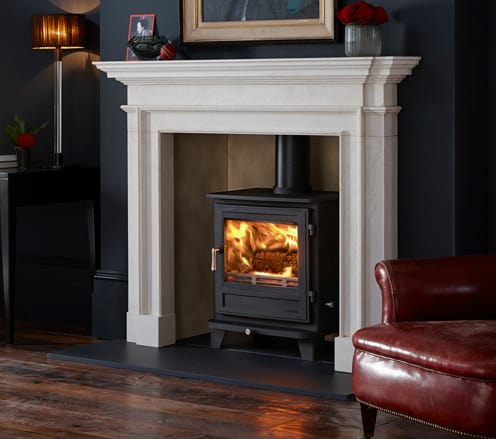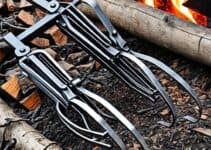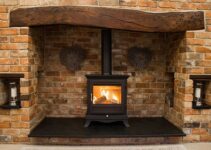Although it’s not an especially common scenario, there are some situations where you might want to swap out an old log burner. For example, if you’re renovating an old property or need to replace a wood-powered central heating system.
In these cases, you might be asking yourself, can a log burner be converted to gas? The short answer is no, a log burner can’t be converted to gas. There are too many safety and logistical considerations for it to be a viable option. Instead, replacing a log burner is a much easier job.
In this article, we’ll discuss this topic in more detail, including looking at which is cheaper to run.
Can You Convert a Log Burner to Gas?
You can’t convert a log burner to a gas fireplace. The most obvious reason is that they’re completely different fuel sources.
Logs are a solid fuel source that’s added to the stove and gas is, well, gas. It’s fed in through a line before being set alight in the burner.
As such, a log burning stove doesn’t have the capacity to burn gas. For starters, it’s not airtight (otherwise the logs wouldn’t burn properly).
Also, the combustion chamber is too big for gas. A gas-powered fire doesn’t need a large combustion chamber, especially if you want the gas to burn at peak efficiency.
However, this isn’t to say you can’t replace a log burner with a gas-powered one. While it can be a relatively expensive job, it’s arguably worth it if you want the ambience of a fire without the upkeep of a log burner.
How to Turn a Wood Burning Fireplace into a Gas Fireplace
Turning a wood burning fireplace into a gas fireplace isn’t too complex. However, it requires very strict safety regulations because you’re working with gas and, eventually, fire.
As such, you’ll need all this work done by qualified professionals.
We can still cover the rough steps so you’ve got a better idea of what the work will involve:
1. Chimney Inspection
The first step is to have your chimney inspected and cleaned. You’ll need to ensure all wood-related residue is removed to reduce the chances of a fire happening.
However, you may need extra hardware installed inside the chimney depending on the type of gas fire you’re having fitted.
2. Adding a Flue or Liner
Some gas fires will need a vent, flue or liner installed in the chimney. Not all gas fires require these, so check with the manufacturer of the model you want to purchase.
Gas fires don’t produce smoke like log burners. However, they produce waste products, including carbon monoxide and dioxide, methane, and more.
Whether you need a flue for these waste products depends on the strength of the gas flame and its efficiency.
The relevant inserts can be fitted inside an existing chimney with no issue. If you’ve had your chimney removed previously, you’ll need a new flue set up, but this is also easy to do.
3. Fitting a Gas Line
Unsurprisingly, a gas burner needs a gas line. It’s identical to the one supplying your gas boiler or cooker. Don’t even think about fitting this kind of hardware yourself (unless you happen to be a qualified gas engineer, of course).
Although fitting a log burner is a fairly straightforward process, you don’t want to cut corners with gas fireplaces. It can quite literally be the difference between life and death, so make sure you get a professional to fit this for you.
4. Adding the Fireplace
There are 3 overall types of gas-burning fireplaces: direct vent, unvented and vented. It’s not necessary to go into the specific differences here, but they mainly come down to whether the fire itself is enclosed (direct vent) or decorative (unvented).
Unvented fireplaces are mainly for decoration rather than use as a heat source. This’ll probably be your main buying factor, but find a supplier of gas fires and discuss your needs with them.
Doing so will help you understand the differences and what impact these may have on installation.
How Much Does It Cost to Convert a Wood Stove to Gas?
To clarify, the cost of this project is the cost of installing a gas fire rather than converting a wood stove to gas. Part of this cost is removing the existing wood stove (if necessary) and checking the existing infrastructure.
So, how much does this all cost?
While it ultimately depends on the type of fire you’re installing, and the quality of your existing setup, expect to pay anywhere up to £2,000.
The gas stove itself can easily cost £1,000 or more, so this is the biggest single cost of the project.
According to CheckaTrade, the cost of plumbing a gas line averages £375, provided it’s within 23 metres of your gas main. Finally, chimney liners can cost £300-£650 to fit depending on the size and condition of the chimney.
You’ll obviously want to shop around for some local tradespeople and quotes to get an idea of how much it’ll cost.
That said, some gas fireplace companies will either offer complete installation or have a network of local specialists.
Does Converting Wood Fireplace to Gas Increase Home Value?
Converting a wood fireplace to gas may increase your home’s value, but this’ll depend on numerous factors. These can range from local buying interests to the cost of gas compared to logs.
The easiest way to look at the project is by using return on investment (ROI). Let’s say converting your log burner to gas costs £2,000 all-in.
That means for it to provide an ROI, it’d need to add less than 1% of the average home’s value (£285,000 in March 2023).
Another way to look at this ROI is in terms of convenience. For example, many modern homebuyers might not appreciate the looks or functionality of a log burner. However, a gas fireplace is more convenient and easier to maintain.
Would they then, by extension, pay to have a log burner removed and replaced with a gas burner? Maybe, but probably not if the cost was high.
If it’s something you want to do and think it’ll be easy to recoup the cost based on convenience for future buyers alone, you’ve got your answer.

Is a Log Burner Cheaper to Run Than a Gas Fire?
The cost of converting a wood fire to a gas fire aside, the other important factor is the cost of fuel. So, is a log burner cheaper to run than a gas fire?
The short answer is yes, the cost of logs as fuel is less than the cost of gas. Considering your gas fire will be supplied from the mains (or a tank), you should already have a rough idea of the fuel price.
The current average price for gas is 10.3p per kWh.
Unfortunately, we can’t provide a specific kWh cost for logs because it depends on too many factors. However, the Wood Fuel Co-Operative has a handy guide on calculating the energy density of various solid fuels.
MoneyWeek claims that a log burner is around 13% cheaper than gas central heating. While this isn’t an especially accurate comparison, it shows that, even when gas prices were at their most expensive, it wasn’t a considerable difference.
You must also factor in things like obtaining, storing and processing logs for your stove. This takes time and effort, which you don’t have when using a gas burner.
So, while a log burner might be marginally cheaper, it takes more overall effort to use.
Final Thoughts
Replacing a log burner with a gas fireplace is a good compromise for modern homes. If you mainly want the cosy vibes without ash and smoke going everywhere, a gas fire is the obvious choice.
Of course, make sure you speak to a qualified gas engineer before making your decision.



